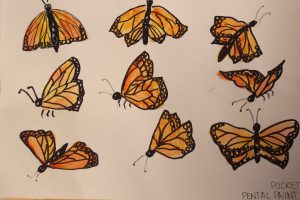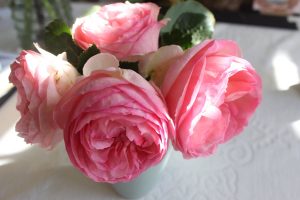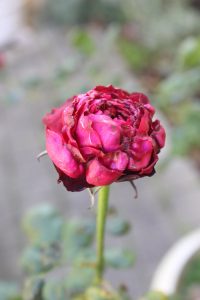SEWING
Are you a home sewer? I had my sewing machine serviced this week. It was the first time in 34 years, so I thought it was due. Actually, I’d tried to mend my husband’s pyjamas and the machine made it clear things had to change. Off to the repair shop. Now it hums along happily. Mostly I mend and modify things, so nothing fancy, just practical.


Home sewing is experiencing a huge boom! Last year the UK recorded a 300% increase in sewing machines sales. Thought to be influenced by a program on television called “Great British Sewing Bee” and CV-19 resulting in more time at home, there’s also a move towards greater sustainability in clothing and a continuing reluctance to shop.


Not only has there been an explosion in the popularity of home sewing, but also knitting and crocheting are wildly popular, too. The UK Craft and Hobby Trade Association estimates over one million people have begun sewing for themselves in the past 3 years.


Sewing machine sales in Sweden have also increased more than 10 fold in the past year. A spokesman for Swiss sewing machine manufacturer, Bernina, says sales figures have literally exploded. (The West Australian newspaper 10/05/2021) Sales of knitting and crocheting materials have increased by eightfold. Availability of Australian grown and manufactured wool has increased enormously and can be found online or in craft suppliers. Good. In the past we sent most of it overseas.
So, is overt consumerism declining? Environmental concerns, a focus on individuality and the pleasure of creating all contribute to the increase in sewing, knitting and crocheting. Interestingly, many bloggers comment on the cost of these activities.


Once seen as thrifty, sewing machines and fabrics are quite expensive and mostly imported into Australia. Others suggest that having invested so much time, energy and money into making clothing or household pieces, they will take more care of them and keep them for much longer. It will be interesting to see if sewing clothes at home will continue.
WATCHING
The Guardian.UK
I enjoyed “Our Yorkshire Farm” and “Escape To The Farm With Katie Humble” but it all became a bit repetitive. Neither of these programs prepared me for ” Clarkson’s Farm”. Jeremy Clarkson has 1 000 acres in Oxfordshire. Fairly clueless, but with great enthusiasm and elan, he farms his 1000 acres. He employs a variety of advisors, farm hands and general contractors in typical Clarkson style.
Of course he buys a huge Lamborghini tractor which doesn’t fit in his shed and really requires an interpreter to keep it working. The pressures of getting jobs done in between rain results in him inventing his own, unsuccessful, methods. Very funny. Especially when his efforts are inspected by 21 year old contractor Kaleb who doesn’t hold back when he critiques Clarkson’s cultivating. The sometimes pointless but remnant EU rules baffle and annoy him, as did six weeks of non-stop rain. More rain than the UK had seen in a century. His farm becomes a quagmire.
So very funny and interesting, peppered with typical Clarkson observations and antics. All accompanied on a cool Saturday morning with a mug of Fridge Soup. In other words, all the vegetables that needed to be used up in the fridge, plus some meaty stock I had and curry paste. Bamixed, pasta added, left to cook some more, then ladled out and enjoyed. There we were, cuddled up with Louis the dog, comfortable and cosy on a cold morning, cackling at Clarkson. (Amazon Prime)


PAINTING


I really enjoy Amy Stewart’s painting tutorials on ZOOM. She delivers one each month. I’d signed up for a session painting monarch butterflies, so a few days before the lesson I found some images, studied the characteristics and painted one on my rose painting.


The monarch butterflies we painted were based on very quick, directed drawings. The focus was on impressions of butterflies, not so much on accuracy. After we’d drawn the shapes we applied a lot of water to each shape and then dropped paint into it. Unpredictable but colourful results. When the paint was dry we used felt and paint pens to add definition and detail. Very different from how I usually paint, but a wonderful opportunity to try other techniques.


Influenced by Amy Stewart’s use of felt pen to add definition and clarity, I completed this poppy painting by adding some pen drawing, too.
CHILLI THRIP
Continuing the war against chilli thrip. Some roses have responded well, others still look dire.


Some of the roses in the back garden have responded well to bi-weekly sprays, plant oil and Seasol. I have been picking the last flush of roses and there’s no sign of chilli thrip. At the end of July all the roses will be pruned right back. I hope they will be healthy next year! I will replace the top layer of soil where the thrip apparently breed with a fresh mix.


Roses out the front have not recovered at all. They had the same treatment as those in the back garden. Less sunlight?


The lime tree, on the other hand, next to the roses out the front, is covered in healthy, delicious fruit!
It’s International Men’s Health week focusing on the well being of all men. For more information www.menshealthweek.org.au/
